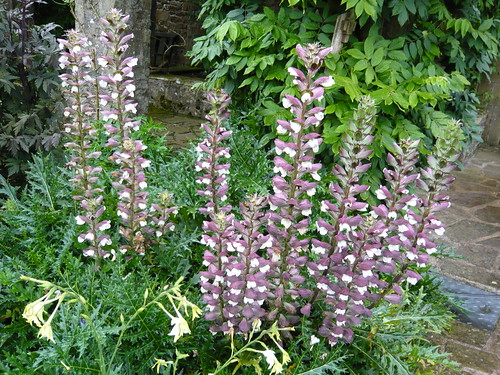Grow Acanthus Varieties

A large clump of Acanthus can produce many flowers on the 2-3 foot stems and you get the architectural leaves thrown in as an extra. The sturdy stems carry a whorl of 30 or so flowers, each producing a shiny, rich-brown, elliptical seed capsule.
Acanthus common name Bears Breeches is a genus of flowering plant named from Greek Akanthos, thorn plant.They were brought to the UK by Romans. An old herbal credits the following treatments which a Roman soldier may have needed:
“The leaves, being bruised or rather boiled and applied like a poultice are excellent good to unite broken bones and strengthen joints that have been put out. The decoction of either leaves or roots being drank, and the decoction of leaves applied to the place, is good for the king’s evil that is broken and runs; for by the influence of the moon, it revives the ends of the veins which are relaxed.â€
“There is scarce a better remedy to be applied to such places are burnt with fire that this is, for it fetches out the fire, and heals it without a scar.â€
Why are they named Bears Breeches or the Oyster plant?
In the 17th century, these were called Brank-ursine, meaning bear’s claws, which referred, possibly, to the shape of the flowers. They contain mucilage and tannin, which makes or rather made them useful in traditional medicine systems in Europe.
Acanthus in Cultivation
- Acanthus grow in well drained soils, they don’t like to sit in water especially during winter.
- The herbaceous species are native to dry rocky hills and make striking border plants. They thrive equally well in both sun and dense shade, although they tend to be more compact and flower more prolifically in sun producing more leaves in shade.
- Acanthus have distinctive leaves at the base and some have fragrant flowers. The flower spikes are useful, when dried, for winter decoration.
- Acanthus make excellent specimen plants in tubs and pots.
- Slow to get a hold they can become hard to eradicate once they get going as they grow strongly from bits of root.
Acanthus Varieties
- Acanthus spinosus AGM has deeply cut leaves which are more or less deciduous and tend to form a dense carpet and they have the trademark mauve and white flowers. Lady Moore or Royal Haughty are varieties to seek out.
- Acanthus mollis Latifolius has the largest leaves of all the Acanthus we have. Both the leaf stalk and the leaf itself are enormous! The flowers are scented, white with a white hood
- Acanthus sennii a north African native has very prickly holly-like leaves, as well as having scarlet flowers. A real head turner!
- Acanthus spinosus spinosissimus group, according to Hillview Hardy Plants, was ‘introduced into English gardens in 1629. Rather shy to flower, but beware of the extremely prickly foliage that makes holly look innocuous!’ A slow growing yet very handsome foliage plant.
- Acanthus balcanicus, dioscoridis, ebracteatus, eminens, hirsutus, montanus and polystachyus are species from tropical climates that have not yet found a place in British gardens
- Acanthus hungarious was origionally from what was Yugoslavia, this plant has deeply lobed light green foliage. Tall spikes of flowers freely produced in late summer. Flowers best in sun but will tolerate shade. 70cm.
- Acanthus Whitewater, also known as variegated bears breeches, is a hybrid of Acanthus Summer Beauty. It has elaborate pink and white flowers on red stems and a spiky base
3 thoughts on “Grow Acanthus Varieties”
Acanthus is a garden triffid! Once you have it, it is there for life! The seed pods shoot their seeds a long distance which is why the coast of Cornwall is covered with Acanthus plants! To be on the safe side cut the flowers before they seed! Val
My acanthus – three plants – has never flowered. They are in a border against the house wall, with little direct sunlight until the late afternoon. The leaves are often holey – unsure of the problem. Suggestions very welcome!
Thank you
Holey leaves may be small snails from the wall but I wouldn’t want to be an Acanthus eating snail they are too spiky.
Comments are closed.